Photos: Kip Miller
We had not been aware of Girona’s famous May flower festival, a hugely popular event in the old town, where stairways, alleys, courtyards and even hidden corners are transformed into imaginative ornamental gardens. “But that’s not all,” Jesús adds in a whisper. “Girona is the city where Queen Cersei walked stark naked through the streets in last year’s final episode of Game of Thrones!” “Well, then, that settles it,” says Eric with a roguish smile. “We’re going!”
It’s the tail end of our trip to northern Spain. My husband and I and our friends Eric and Kathy agree to visit 2,000-year-old Girona on our free Sunday. “The best way to get there is to take the high-speed train out of Barcelona’s Sants station, says Jesús. “You will barely have time to finish a coffee before arriving. The train ride lasts approximately 39 minutes,” he adds as he orders our 21-Euro tickets on-line. “If possible,” I ask Jesús, “can you try to get us a reservation for late lunch at El Celler de Can Roca?” This three-star Michelin restaurant was recently named the World’s Best in “Restaurant Magazine.” “For sure, I will try,” he smiles, “but it will be tough.”
Girona has
been on my Spain bucket list for decades. Nestled in the Catalan Pyrenees
and crisscrossed by four rivers, it is filled with labyrinthine cobbled
streets, medieval churches, Moorish-inspired baths and Carolingian fortress
walls, not to mention El Call, an atmospheric Jewish quarter dating from
the 9thth century, where the study of Kabbalah, Judaism’s mystical
interpretation of the bible, once flourished. Girona began as a Roman
outpost, weathering 23 sieges by a variety of conquerors throughout its
turbulent history, including a humiliating defeat by Napoleon’s troops.
Today, this city of 100,000 souls manages to retain its small town atmosphere,
providing a popular escape for visitors from Barcelona, the Costa Brava
and even France.
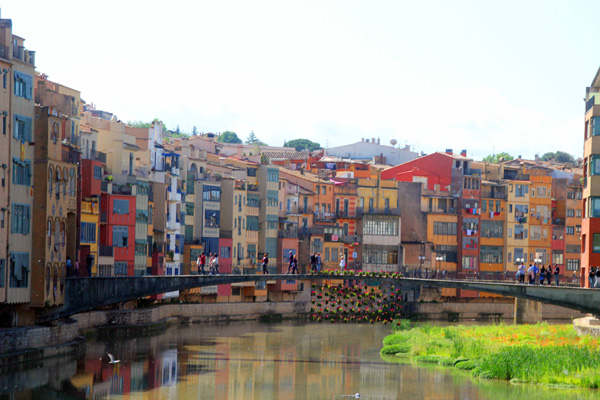
The Onyar River abuts Barri Vell, Girona’s atmospheric old town. Dusty rose and muted yellow facades reflected in the water have become an iconic image of the city.
Early on Sunday we board a sleek train at Sants, the only passengers in
our first-class car. Viewed from our picture window, the green countryside
is but a blur as the train hurtles along at a speed approaching 200 miles
per hour. “This train puts our American rail system to shame,”
sighs my husband. Off in the distance, we can make out snowy Pyrenean
peaks rising against blue skies and billowy clouds. The train comes to
a seamless halt. We rush out of Girona’s station, hail a taxi to
the old town and are soon deposited at Placa Independencia abutting the
Onyar River. “This riverfront sure has atmosphere,” says Kathy,
admiring the long row of dusty rose and burnt orange facades reflected
in the water, their colors chosen by local architects to echo the wildflowers
that grow in the area. Schools of tiny fish rush through the river. Several
foot bridges span the Onyar, providing quick access to the historic section.
One is particularly unique, fashioned of red metal in a crisscross design.
“That’s probably the Gustave Eiffel Bridge,” I venture
a guess. “It was built around 1877.”
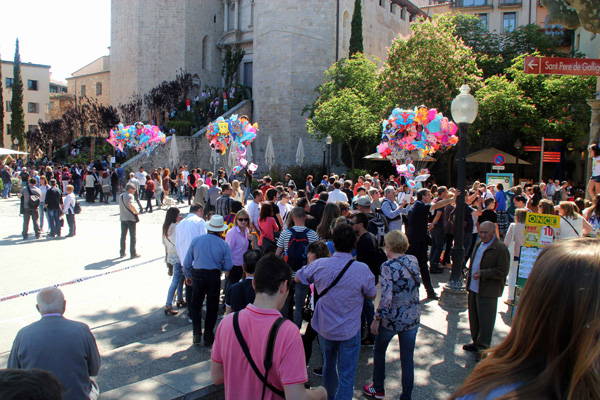
Thousands of visitors crowd the annual Flor de Temps festival where nearly 150 imaginative floral displays adorn courtyards, alleys, stairways and hidden corners.
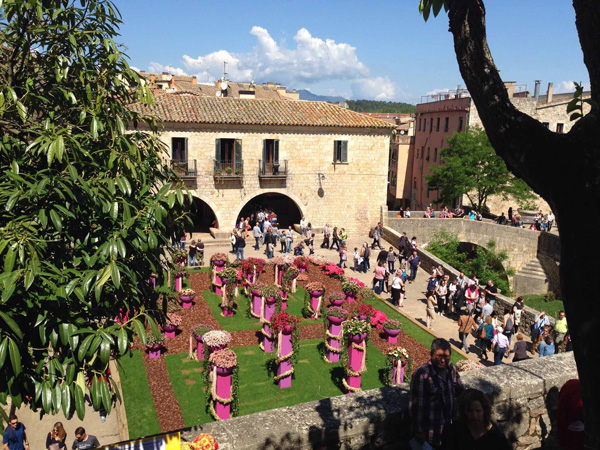
Geranium “hats” crowned with lavender columns and ivy garlands enliven Placa dels Jurats, a favorite gathering spot for city celebrations and performances.
Straight ahead of us a wooden bridge leads to a small square fronting
Saint Feliu, a graceful Gothic collegiate church that once served as Girona’s
first cathedral. All around us buses are disgorging noisy families headed
to the festival. We blend into the holiday crowd, but the line waiting
to enter Saint Feliu is daunting. “What an avalanche of people,”
says Eric. “Will we even be able to get close to the sites?”
A narrow lane winds to the church of Saint Pere de Galligants, a Benedictine
complex distinguished by a Romanesque belfry dating from the 12th century.
A sign points to Girona’s archaeological museum housed inside. We
admire it from afar, but are unwilling to stand in line. “Too bad,”
I grumble as I look up Galligants in my guide book. “It would have
been nice to see its beautiful cloister with carved capitals resembling
vegetables.” We peruse our Temps de Flors map listing the locations
of nearly 150 imaginative floral displays. Many of these creations have
a sense of humor, bending the imagination: rows of tomatoes in geometric
patterns, a sea of cauliflowers accented by yellow daises, lavender columns
crowned with geranium hats and ivy garlands, faux cattails, and enormous
plastic eggshells bursting with “chick” marigolds, to mention
just a handful.
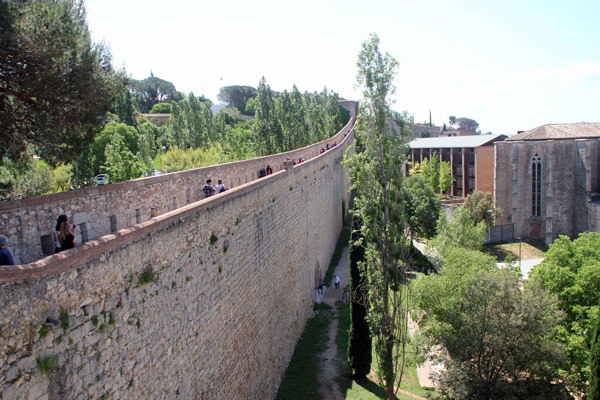
Girona’s soaring 9th century walls were added to Roman foundations during the Carolingian era. Visitors are protected by parapets as they stroll above the old town.
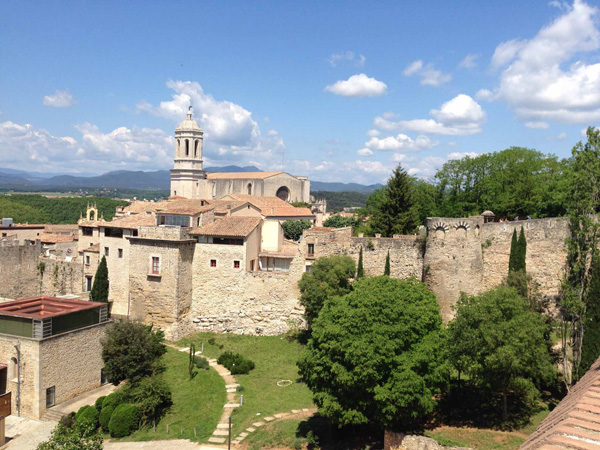
A grandiose cathedral towers over Girona’s labyrinthine core. Hidden beneath the mammoth structure are remnants of the former Cardo Maximus.
“How about if we try to see the Arab Baths,” I suggest, having
read about its exquisite changing room built around a pool covered by
a cupola that opens to the sky. Dating from the late 12th century, the
baths are an artful adaptation of the Moorish style that became very fashionable
throughout Spain. “But who has the patience to wait,” sighs
my husband, eyeing the crowds again. By now we are desperate to break
away from the hordes. Girona’s ramparts loom ahead and we cross a
stone bridge spanning the ancient moat that once encircled the city. From
here the climb begins in earnest to the Passeig de la Muralla, the dramatic
walk on Girona’s walls. During the reign of the Aragonese King Peter
the Third, the original Roman ashlar walls were extended to enclose the
old city, with circular turrets to provide strategic lookouts over the
entirety of medieval Girona. Leaving several winding staircases behind,
we reach a long flat walkway protected by parapets on each side. “Worth
the effort!” exclaims Kathy as she focuses her camera on a panoramic
view of the old town and the Catalan foothills beyond. The university
campus spreads beneath us, and to the right, Girona’s massive cathedral
towers over its medieval core. Here and there hidden courtyards and tiny
rose gardens provide a bird’s eye view of how the locals live.
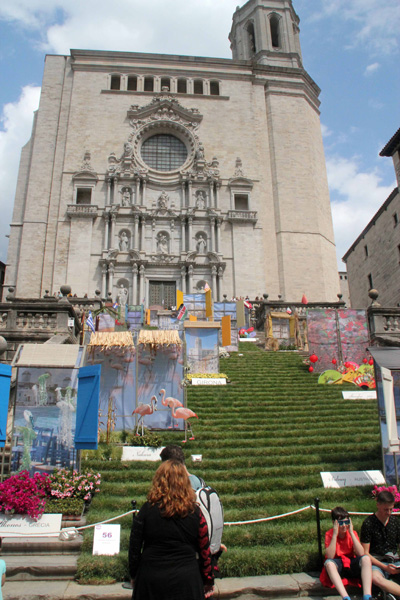
Eighty-eight steps descend from the cathedral’s neoclassic facade to the
lower town. Each year the steps are a highlight of the flower festival.
We retrace our steps and descend to the cathedral, a massive structure
built in the 11th Century in Romanesque style over the foundations of
an ancient Roman temple. Undergoing numerous stylistic changes over the
centuries, it is renowned for its enormous Gothic nave, the widest in
the world after St. Peter’s in Rome. Eighty-eight steps, today adorned
with festival plantings, connect the cathedral entrance to the lower town.
From the top of these stairs in Game of Thrones, naked Queen Cersei began
her demoralizing descent to derisive cries by the townspeople. I later
learn that Girona’s cathedral elders were vehemently opposed to having
such a lewd scene take place on “their” stairs, forcing HBO
to film the offending portion on a similar staircase in Croatia! From
the cathedral loggia, one is only minutes away from the narrow alleys
of the Call. We blend into a sea of people and begin to think about lunch.
Kathy checks her phone to find a message from Jesús: “El Celler
is not open today, but I recommend Draps.” No other choice but to
follow the crowd heading down a winding street. “Jesús must
be a wizard,” I remark as we walk past an airy modern restaurant
with a few remaining empty tables. “It’s Draps, can you believe
it?”
As it turns out, Draps is not far from the heart of the Call and even
offers a few entrees labeled “Sephardic” – kosher selections
created for Jewish tour groups that frequent Girona. The chef specializes
in dishes “to be shared,” meaning that all the portions are
huge. But so are our appetites after the climb up and down. I watch two
servers adding final flourishes to a luscious garden salad with organic
greens, olives and citrus. Patrons at an adjoining table are feasting
on marinated octopus tossed with grilled vegetables and fresh herbs. A
waitress is carrying an oversized platter laden with aromatic shrimp and
lobster to an outdoor table of animated young couples. Salads and octopus
for us, we decide. Draps embodies the concept of farm-to-table ingredients
and our lunch is a refreshing feast accompanied by out-of-the-oven bread.
“Maybe we can try Girona’s famous gelato later,” I suggest.
“The three Roca Brothers who own El Celler recently opened a gelateria
that is famous for its unique flavors. I’ve read that the baked apple
sorbet is amazing!” “If only we could find it,” sighs Eric.
Catalonia and the adjoining Basque region are the epicenter of haute cuisine in Spain. Here one will encounter more Michelin-starred establishments per square meter than almost anywhere else in the world. For it was here that Ferran Adrià invented a slew of new techniques that are known as molecular gastronomy--a deconstructed cuisine based on chemical reactions, resulting in nuanced tastes never experienced before. In the hierarchy of the culinary world, he is regarded as the “Gaudi of modernist cooking.” Girona’s three Roca brothers had worked with Adrià when his “El Bulli” restaurant was ‘the’ place to dine in all of Spain, as well as some of the best kitchens in the region, but their cuisine is more firmly rooted in the traditions of their family kitchen. “We have to come back one day on a food tour,” says Kathy, sighing over her lunch.
A wrong turn
brings us down to the Onyar, where dozens of trendy boutiques and cafes
lining Rambla de la Llibertad are enjoying a brisk business. Somehow we’ve
missed the Call, and make inquiries at the tourist office next to the
river. “Just continue up on this street until you reach the Cathedral
area,” says the helpful attendant. “Turn right, and then go
down Caller de la Forca. That’s where the Jewish Museum is.”
The ascent toward the Call is a delight. Every street lantern on the Rambla
is covered with a transparent pink umbrella shielding huge crepe paper
blossoms. I am enthralled by the variety of floral displays adorning door
stoops and window sills. A sweet aroma wafts from bakeries crammed with
trays of holiday macaroons. Loud holiday music enlivens crowded bars specializing
in craft beers.
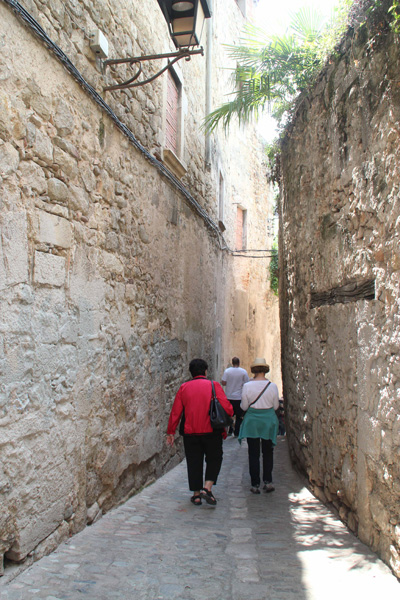
Girona’s atmospheric Jewish quarter is characterized
by narrow, winding lanes and dark covered alleys.
Girona’s Jewish community flourished for more than 600 years, at its peak comprising 10 percent of its total population. The community was quite prosperous, with many merchants, artisans and accomplished scholars. As the world’s leading center in Kabbalistic studies, it was regarded as “The Mother Town of All of Israel.” Girona’s most famous rabbi, Nahmanides (Ramban), is revered nearly as much as Cordoba’s great physician and rabbinic scholar Maimonides (Rambam). The Call’s warren of narrow, winding streets and covered alleys constitutes one of Europe’s best preserved Jewish quarters. Its name, Call, derives from calle (street) in Spanish and kahal (community) in Hebrew. Those with discerning eyes can spot tiny slits in a few walls where mezuzot (rolled parchments inscribed with verses from the Torah) were placed near the doorposts of Jewish homes. “I am in awe,” says my husband as we wander down a tiny cobbled street.
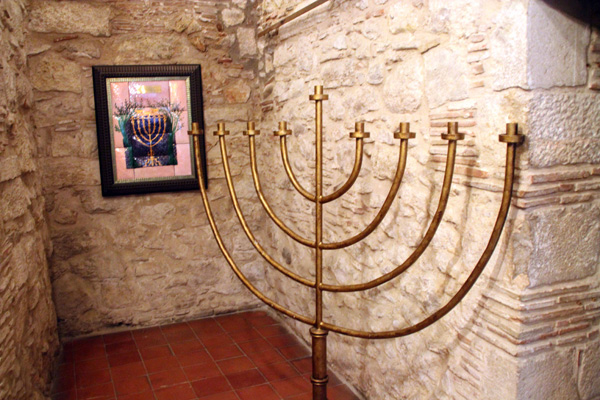
A centuries-old brass menorah is showcased in the Jewish Museum on Bonastruc ca Porta. Among its many displays are carved synagogue stones, marriage ketubahs (contracts), and gravestones from the cemetery on Montjuic.
A courtyard with a large Star of David embedded in the pavement fronts
the museum, situated on the narrow Carrer San Llorenc, a steep alley that
had been blocked off for centuries. Recent excavations nearby have revealed
remnants of a synagogue, a ritual bath and even a butcher shop. Here also
sits the Nahmanides Institute for Sephardic Studies and a shop packed
with a sizable collection of books, menorahs and other religious items.
A pamphlet quoting the director of the museum, Assumció da Hosta,
explains that the museum’s founding was spearheaded mostly by non-Jews,
along with the assistance of a few foreign scholars and the small but
vibrant Jewish community of Barcelona. It came into being after the 500th
anniversary of the expulsion of the Jews from Spain was noted in 1992,
and interest in preserving and celebrating Girona’s rich Jewish heritage
has been growing ever since. “We are striving to bring the voice
that was silenced for 500 years to life again,” Hosta writes. “Who
knew?” I whisper to my husband as we enter the museum. On display
are rare manuscripts, artifacts and gravestones inscribed in Hebrew that
were transported from the Jewish cemetery of Montjuic just outside the
city walls. Interlocking chambers reveal small interior patios that were
once filled with flowers.
Girona’s
Jews prospered for centuries under the protection of the king, often ranking
among Europe’s elite, enjoying good relations with their Christian
neighbors. But during the violent outbreaks that swept through Spain in
August 1391, the community had to take shelter in the Tower of Gironella,
the highest point of the Call. After 17 weeks of isolation, they finally
returned to their homes, finding many in ruins. Life became perilous and
Jews were required to wear identity badges on their clothing, not unlike
the yellow Stars of David required by the Nazis centuries later. Taxes
imposed on the community grew more exorbitant, and doors and windows of
Jewish houses that overlooked routes frequented by Christians were required
to be sealed. By 1492, Girona’s rich Jewish life came to an abrupt
end. At that time fewer than 300 people still remained in the Call. I
remember reading that on the eve of the 500th anniversary of the expulsion,
Spain bestowed its highest honor—the Prince of Asturias award—on
all the world’s Sephardic Jews. That year a whole flurry of seminars
and exhibits were mounted throughout the country, attracting hordes of
Jewish visitors. A long line of tourists is waiting behind us to see the
museum, so we move on to the shop. “Isn’t it wonderful that
the Catalan community has stepped up to reclaim its Jewish heritage!”
says my husband as we peruse their collection of books.
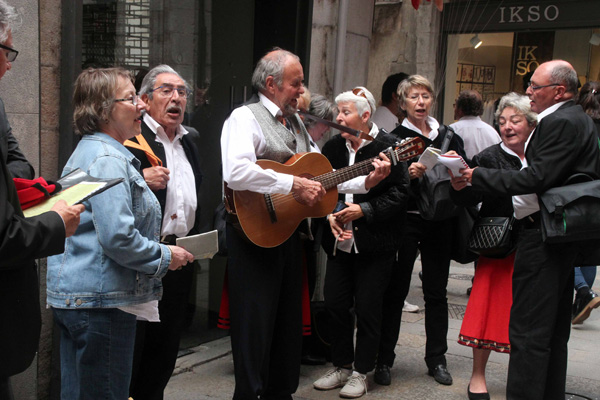
Festival attendees burst into patriotic song to the accompaniment of a guitar. Fiercely proud of their region, many Catalonians currently seek independence from Spain.
All visitors are eventually drawn to Girona’s riverfront neighborhood.
We blend into the festival crowd and soak up the holiday spirit. The town
is all dressed up to party, its floral displays injecting color and whimsy
at every turn. Many couples with children are strolling with their family
dog, the latter appearing to have just left the groomer. Music drifts
out of the recently restored Municipal Theater boasting a gilded auditorium
with red velvet seats. It is a full-throated choir, undoubtedly part of
the A Cappella Music Festival that takes place simultaneously with Temps
de Flor. We watch as a group of people gathers around two men strumming
guitars, all breaking into a patriotic song. I survey the impressive array
of Belle Epoque and Modernist buildings around us. Nearly every window
and balcony is draped with the orange and white striped flag of Catalonia.
In Girona the locals prefer to speak Catalan, rather than the Spanish
they also know. I try to understand it, but it eludes me, a unique blend
of French and Spanish that grew out of Latin so long ago. Straight ahead
a circle of dancers break into the Sardana, the regional folkdance, moving
in small steps to one side, and then arms raised, moving to the other.
Shouts of “Visca el Barca” (idiomatic for “long live Catalonia”)
can be heard over the music.
The separatist fervor that has swept through the Basque Provinces is even more pronounced in Catalonia, a proud region dating back the 9th century. During the Franco regime, Catalonia’s identity and language were severely repressed, its institutions completely abolished. Today the movement has been reborn and continues to gain steam. Catalonia is now the wealthiest and most industrialized area in Spain and its restive people complain that they are propping up the entire Spanish economy. Recently, the regional Catalan parliament voted to begin the process of breaking away from Spain, paving the path for an independent Catalan state. The new Catalan president is the pro-separatist Carles Puigdemont, a native of Girona, no less. “How all of this will end remains to be seen,” comments Eric. “You can sense their pride and determination just by the way they sing,” I murmur as I walk past a group of youths singing with gusto.
The afternoon sun is casting long shadows as we cross the Onyar to Placa Independencia, a huge arcaded plaza lined with 19th century buildings designed by Marti Sureda, Girona’s great municipal architect. Every café in the square is packed with people, not an empty seat to be had. At the far end an elevated festival stage is featuring a dozen musicians in a rollicking performance of traditional regional music. The audience is cheering, their glasses raised in boisterous toasts as they all join the performers in song. We would love to linger and digest the scene, but it is getting late. “Next time, we have to stay for a few days,” I tell my husband as we board the train to Sants, “preferably right in heart of the old town. And we’ll need to make that reservation for Celler de Can Roca months in advance.” Kathy nods in agreement. “How about including a side trip to Figueres to see the Dalí Museum?” she suggests. “And let’s make a few stops on the Costa Brava,” adds Eric to round out the plan, “complete with some Michelin restaurants!”
In just under an hour we are back in Barcelona, comfortably ensconced at the Avenida Palace near the Eixample District, our spirits high. “What a great day!” I sigh as I pull up my blanket, exhausted but elated. I nod off, envisioning myself surrounded by hundreds of townspeople on the Game of Thrones set. Minutes later, I am strolling through Girona’s labyrinthine streets. The holiday crowds have vanished and I have the town all to myself. Church bells are tolling in unison as I enter each place of worship, taking in every resplendent nave, treasury and cloister. At the Arab Baths, I lean against an elegant column and dip my toes in the perfumed octagonal pool. But it is the heart of the Call that beckons me above all. I enter the study of the great Ramban. He does not see me standing silently over his shoulder. I close my eyes in reverence, soaking up the wisdom of the Kabbalah.
